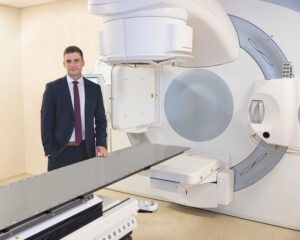Cervical, Vulvar, and Vaginal Cancer Treatment Options
Fighting cervical, vulvar and vaginal cancer with pinpoint accuracy.
At MRO, we use precise doses of radiation to destroy cancer cells, which are more susceptible to radiation than healthy cells. Using state-of-the-art imaging technologies such as MRI, CT, and PET, your MRO care team can pinpoint radiation doses down to the millimeter. By focusing the radiation directly on the tumor and surrounding tissues, these therapies are designed to reduce the risk of common gastrointestinal and sexual function side effects.
Radiation therapy may be used for cervical cancer:
- As a part of the main treatment. For some stages of cervical cancer, the preferred treatment is radiation alone or surgery followed by radiation.
- Along with chemotherapy (called concurrent chemoradiation). The chemo helps the radiation work better.
- To treat cervical cancer that has spread or that has come back after treatment.
![]()
With cervical, vaginal, or vulvar cancer, there are several different types of treatment techniques that can be used. Although the choice of treatment depends largely on the stage of the disease, other factors that may influence your options are your age, your general health, your individual circumstances, and your own preferences. Cervical cancer can affect your sex life and your ability to have children. These concerns should also be considered as you make treatment decisions.
At MRO, we use precise doses of radiation to destroy cancer cells, which are more susceptible to radiation than healthy cells. Using state-of-the-art imaging technologies such as MRI, CT, and PET, your MRO care team can pinpoint radiation doses down to the millimeter. By focusing the radiation directly on the tumor and surrounding tissues, these therapies are designed to reduce the risk of common gastrointestinal and sexual function side effects.
Radiation therapy may be used for cervical cancer:
- As a part of the main treatment. For some stages of cervical cancer, the preferred treatment is radiation alone or surgery followed by radiation.
- Along with chemotherapy (called concurrent chemoradiation). The chemo helps the radiation work better.
- To treat cervical cancer that has spread or that has come back after treatment.
With cervical, vaginal, or vulvar cancer, there are several different types of treatment techniques that can be used. Although the choice of treatment depends largely on the stage of the disease, other factors that may influence your options are your age, your general health, your individual circumstances, and your own preferences. Cervical cancer can affect your sex life and your ability to have children. These concerns should also be considered as you make treatment decisions.
At MRO, we use two types of radiation therapy for gynecologic cancers:
 External beam radiation therapy (EBRT): External beam radiotherapy is the most common form of radiation treatment; it delivers radiation to cancer cells from outside the body, using a machine called a linear accelerator (LINAC) to direct high-energy radiation beams to the exact location of the cancer.
External beam radiation therapy (EBRT): External beam radiotherapy is the most common form of radiation treatment; it delivers radiation to cancer cells from outside the body, using a machine called a linear accelerator (LINAC) to direct high-energy radiation beams to the exact location of the cancer.
High dose rate (HDR) brachytherapy: Brachytherapy delivers high doses of radiation from implants placed close to, or inside, the tumor or tumor bed in the uterus, cervix, and/or vagina. Devices called high-dose rate (HDR) remote after-loading machines allow MRO radiation oncologists to complete the brachytherapy procedure in just minutes. Depending on the area treated, you may receive several HDR treatments over several days. Once your treatment is finished, your MRO radiation oncologist will remove the radiation source and the catheter or applicator.
Sometimes both brachytherapy and external beam radiation therapy are used. How much of the pelvis needs to be exposed to radiation therapy and the type of radiation used depend on the extent of the disease.
Like an x-ray, radiation therapy is painless. And for patients who receive external beam radiation therapy, there’s no fear of becoming radioactive during or after treatment.
“I enjoy the privilege of establishing professional relationships and working directly with so many brave patients while sharing advances in technology and tailoring treatments to maximize effectiveness and minimize side effects.”
Daniel A. Wattson, MD
MRO | Fairview Southdale